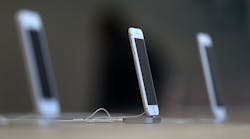At least one company in Apple Inc.’s supply chain is already reaping the benefit from plans to outfit next year’s version of the iPhone with a brighter, higher-definition screen.
The first evidence came last week when Applied Materials Inc. reported an almost fourfold leap in orders for equipment to make displays, an early sign that producers are retooling their manufacturing to meet Apple’s demand for a new kind of organic light-emitting diode, or OLED, screen. The technology will allow Apple to upgrade the biggest component of its main product.
“Some tooling or machinery orders now set up suppliers for the fall of 2017,” said Gene Munster, a Minneapolis-based analyst at Piper Jaffray. “It sets up the iPhone in the fall of 2017 to be more of an impactful upgrade than the fall of this year.”
Apple spokeswoman Trudy Muller declined to comment.
Apple needs new features to rekindle growth while the smartphone market slows as consumers take longer to upgrade their handsets. The company’s quarterly sales fell for the first time in 13 years in the three months through March as iPhone demand waned. Investors are divided over whether the decline shows that smartphone sales have peaked, or whether current customers are waiting for the new iPhone model before they buy.
A new screen might help Apple foster future growth. For Applied, the flood of orders isn’t a one-quarter event, its management said. That highlights both the scale of investment needed to produce such technology and the amount of capacity needed to supply Apple. Applied, the biggest maker of machines that manufacture screens, said new orders for that division totaled $700 million in its second quarter, close to what it normally gets in a year. Orders were $180 million in the three-month period a year earlier.
“It’s not a peak or a one-time event,” Applied Materials CEO Gary Dickerson said. “This is going to be sustainable growth. We all know who is the leader in terms of mobile products.”
Emphasizing that the new displays will make their way into the iPhone in 2017, rather than in the new device expected to be introduced in September, Applied said it takes as long as three quarters to build, deliver and install their large machines.
OLED screens are thinner because they don’t require a back light. They also represent colors more vividly and are more energy efficient, which could help extend the iPhone’s battery life. Samsung Electronics Co., LG Display Co. and Foxconn Technology Group-owned Sharp Corp., all of whom are Apple suppliers, have announced increased spending on the new display technology in the past two months.
Apple is the biggest customer for all three companies, with Sharp getting about 20% of its revenue from the Cupertino, California-based company, LG Display receiving more than 30 percent and Samsung deriving 4.8%, according to data compiled by Bloomberg. Analysts also expect Samsung to use the new screen technology in its top-of-the-line handsets.
LG Display CFO Kim Sang-Don said last month that his company was improving its OLED offering for mobile. After being acquired by Foxconn in March, Sharp said earlier this month it plans to pour 200 billion yen into the production of screens based on the technology.
Unlike liquid crystal displays, which Apple currently uses, OLED doesn’t need a back light to provide illumination. It takes advantage of the natural luminescence of certain organic substances in response to electric current. That means that compared to LCD, OLED displays are thinner, use less battery power and have higher contrast providing a higher-definition image.
The technology also makes curved displays possible and could lead to flexible screens in the future. OLED has taken longer to become a mainstream product because it’s more difficult to manufacture than LCD.
In related news, many of Apple’s Taiwanese suppliers received a market boost Monday thanks to iPhone 7 news: iPhone assembler Pegatron surged 9.9%; Catcher Technology, which provides metal casing for the handsets, jumped 9.7%; chipmaker Taiwan Semiconductor Manufacturing increased 3.7%; and components manufacturer Hon Hai Precision Industry, or Foxconn, rose 4.6%.
By Alex Webb and Ian King



